Rug Guide
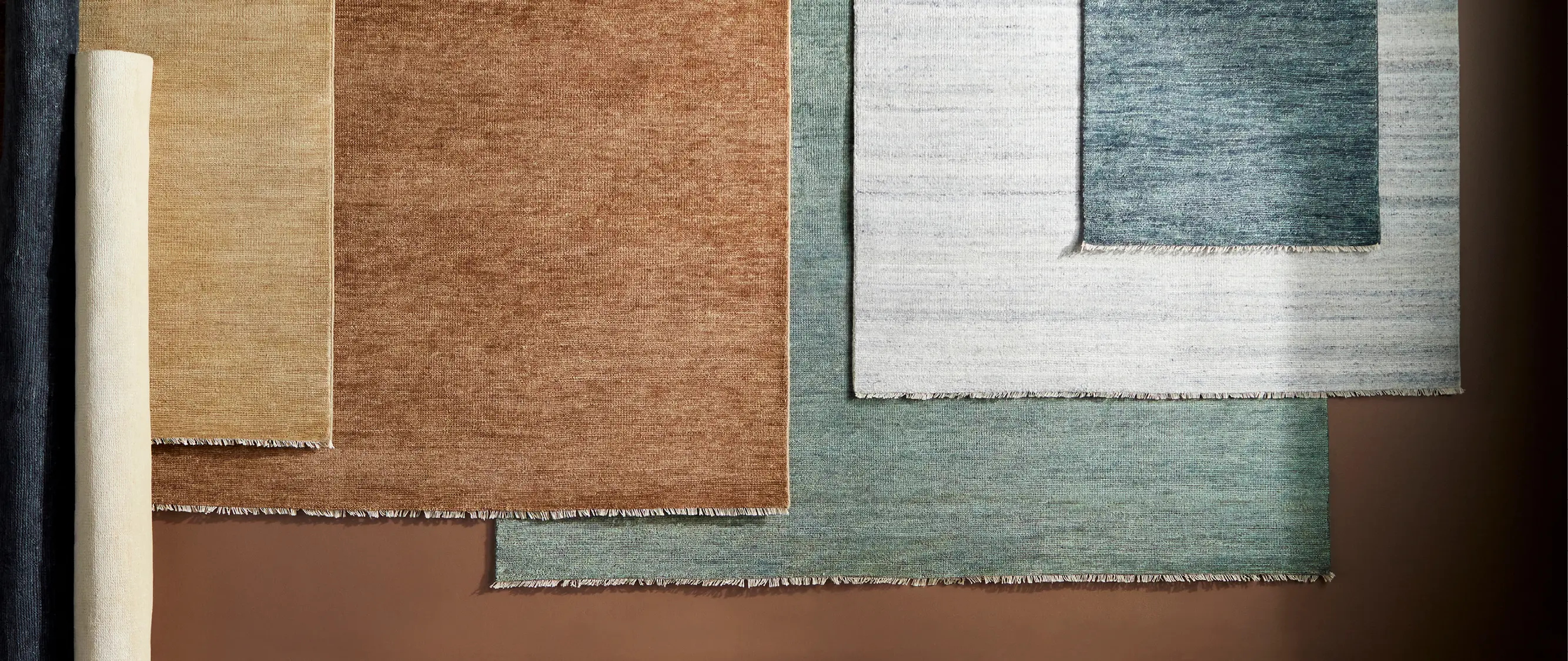
Adding a rug is one of the easiest ways to freshen the look of a room. Rugs can anchor a room, define it, add warmth and help layer a room’s decor. All Surya rugs are made from the finest quality materials to ensure strength and durability. But, like any investment, a rug must be properly taken care of if it is to last. Our Rug Guide provides you with valuable tips and resources to help ensure your rug can be enjoyed for years to come.
- Common Concerns
- Constructions
- Materials
- Sizing
- Care & Cleaning
- Pads
- Storage
Common Concerns
All Surya rugs are handmade by skilled artisans or machine woven in a specialty manufacturing facility, and are checked to meet quality standards before shipment. We stand behind our products 100% but understand that there are some common concerns about rugs that may require further explanation.
Handmade rugs may have slight variation in design, color, and size (3%-5%) which are not considered defects.
Machine woven rugs may have slight variation in size (up to 2%) which are not considered defects.
Shedding is considered normal and will vary depending on the construction and content. Shedding will usually subside over time, although some rugs may have mild shedding for the lifetime of the rug. It typically takes 20-25 vacuums at a minimum (depending on foot traffic) to curtail shedding.
Hand tufted rugs will have the highest shedding, while machine woven rugs have the lowest shedding.
Wool and viscose have the highest shedding, while polypropylene, olefin, polyester, acrylic and nylon have the lowest shedding.
Sprouting is a normal part of the break-in process where loose yarns are pulled up above the surface of the rug. This is considered normal and will vary depending on the rug construction and content.
To remove sprouts, use scissors to carefully trim the sprouting yarn even with the pile.
Do not pull sprouts out of the rug, as this causes additional sprouting and damage.
Hand hooked rugs will have the highest sprouting, while machine woven rugs have the lowest.
Because rugs are rolled for shipping and storage, they may have creases or curling when first unrolled.
Creases should disappear within a week or two when the rug is laid out flat.
Reverse rolling the rug overnight will help to release creases.
Dyes, yarns, backing and packing material all have natural odors that are sometimes magnified after being sealed for shipping and storage.
Odors should dissipate within a week once the rug is removed from the packaging.
The colors in your rug will fade with time, even if the material is fade resistant.
Direct sunlight will cause faster fading than indirect sunlight.
Rotating your rug every 3-6 months will distribute the fading more evenly over the rug which reduces the appearance of fading.
Jute and Wool will fade the fastest.
Polypropylene and olefin are the most fade resistant materials because they are solution dyed.
Polyester, acrylic and nylon also fade much more slowly than natural materials.
Constructions
Below is a brief overview of the most common rug constructions. No one construction or material is better than any other, but they each have inherent characteristics that make them better suited for different uses. Learn about the advantages and disadvantages of the different constructions to find what works best for you.
| CONSTRUCTION | HOW IT’S MADE | BENEFITS | OTHER CHARACTERISTICS | |
|---|---|---|---|---|
 | Hand Knotted Watch The Video. | Each knot is tied by hand, one-by-one | Artisan product, highest perceived value, very durable (except in delicate materials), can achieve intricate details | Size/design/color may vary slightly, higher price than other constructions |
 | Hand Tufted Watch The Video. | Hand-operated tool is used to punch yarn through a canvas | Best-selling construction, many textures are possible; predominantly cut pile | Size/design/color may vary slightly, more shedding than other constructions |
 | Hand Hooked | Hand-operated tool is used to punch yarn through a canvas | Crafted/artisanal look; predominantly looped pile | Size/design/color may vary slightly, more sprouting than other constructions |
 | Hand Loomed Watch The Video. | Woven on a large, hand-operated loom | Can be cut pile, loop pile, or cut and loop pile; often a solid color base is hand carved to create a subtle design. can also be overtufted or printed to create a textural/colorful design | Size/design/color may vary slightly, limited to simple/border designs or solids |
 | Hand Woven (flatweave, dhurrie, kilim, peddle-weave) | Woven by hand on an upright loom or peddle loom | Shedding is less than other hand made constructions, often reversible and foldable | Size/design/color may vary slightly, can feel coarse because there is no pile, limited to designs which are geometric, simple, or repetitive |
 | Hand Woven (shag, texture) | Woven by hand on a pit loom or punja loom | Highly textural, high perceived value | Size/design/color may vary slightly, typically very thick which can be difficult to walk on or place furniture on |
 | Hand Crafted | Animal hides are cleaned and finished by hand; other unconventional rug techniques may be categorized as Hand Crafted | Natural/crafted look | Size/shape/coloration will vary from piece to piece since every natural animal hide is completely unique |
 | Machine Woven | Mechanically woven on a large loom machine | Typically lower price than handmade rugs, little-to-no variation from piece to piece, typically minimal-to-no shedding and suitable for high traffic areas since it’s easy to clean | Typically does not last as long as handmade constructions |
Materials
There are countless rug materials, especially considering that two, three or even more materials may be used in a single rug. Below are some of the essential materials used in Surya rugs. Each material has specific benefits and characteristics that are unique based on origin.
Natural animal rawhides with hair/fur still attached are cleaned and finished by hand. They are moisture resistant and biodegradable. Surya uses only cow and sheepskin hides and since no two animals have exactly the same markings or coloration, every product made with Hair on Hide or Sheepskin will have natural variation in shape, markings and coloration.
Cellulose fiber extracted from a plant then spun into yarn. This material is sustainable, biodegradable, durable and affordable. It is also moisture resilient and embodies natural color variation. It feels coarse and has high shedding if used in pile construction but minimal otherwise. Dyed and undyed colors will vary based on the time of year when the fibers are harvested.
Protein based fiber from New Zealand sheep’s fleece is spun into yarn. This wool is higher quality than normal Wool and has more softness, natural sheen and less shedding. Dyed and undyed wool products will vary in shade from piece to piece and will fade with exposure to sunlight. All wool sheds, however this varies depending on the quality and will reduce over time.
Synthetic (man-made) made by extruding polymers or petrochemicals and solution-dyed in a liquid state before it is formed into yarn. It is highly durable, moisture, fade and stain resistant, with minimal-to-no shedding or color variation. This material has a slight chemical odor which will fade over time.
Synthetic (man-made) made by extruding polymers or petrochemicals and yarn-dyed. It is highly durable, moisture and stain resistant with minimal-to-no shedding. This material has a slight chemical odor which will fade over time.
Cellulose pulp from wood is first extracted using recyclable solvents and then spun into yarn. Tencel imitates the look and texture of silk at a lower price and is sustainable and biodegradable. It is soft with a silky appearance and lustrous sheen. It is not recommended for high traffic areas due to high shedding since non-resilient fibers can mat and make stains difficult to clean. Tencel is more durable then viscose and will shed less than viscose. However, it is less durable that synthetic fibers and wool.
Hybrid of natural cellulose pulp and synthetic fibers is regenerated through chemical processing and spun into yarn. This material imitates the look and texture of silk at a lower price. It is biodegradable with a soft appearance and has a silky feel with lustrous sheen. It is not recommended for high traffic areas due to high shedding since non-resilient fibers can mat and make stains difficult to clean.
Protein fiber from sheep’s fleece which is agitated, usually with water, at a high temperature so the fibers mat together. Wool yarn is sustainable, biodegradable, highly durable and highly resilient with natural oils that provide softness. Dyed and undyed wool products will vary in shade from piece to piece and will fade with exposure to sunlight. All wool sheds, however this varies depending on the quality and will reduce over time.
Protein based fiber from sheep’s fleece is spun into yarn. Wool yarn is sustainable, biodegradable, highly durable and highly resilient with natural oils that provide softness. Dyed and undyed wool products will vary in shade from piece to piece and will fade with exposure to sunlight. All wool sheds, however this varies depending on the quality and will reduce over time.
Sizing
- Living Room
- Dining Room
- Bedroom
- Kitchen
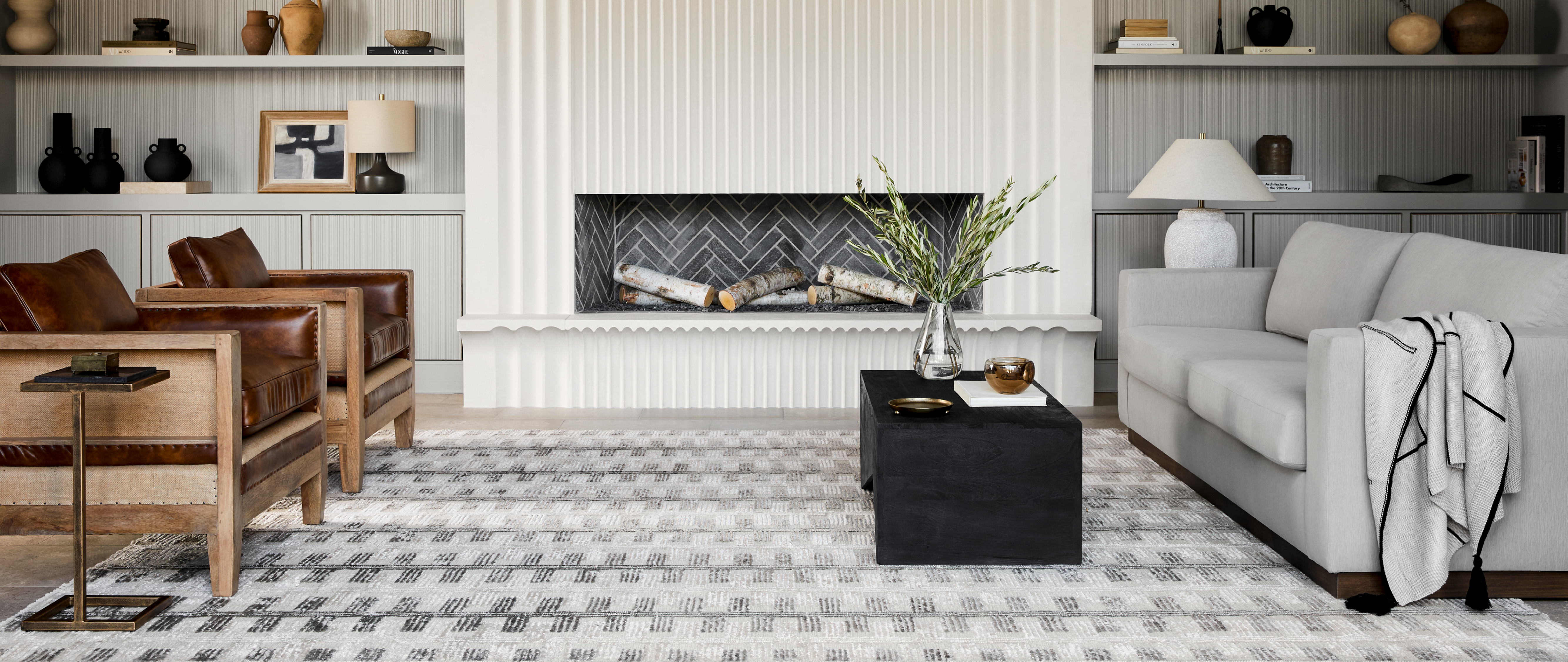
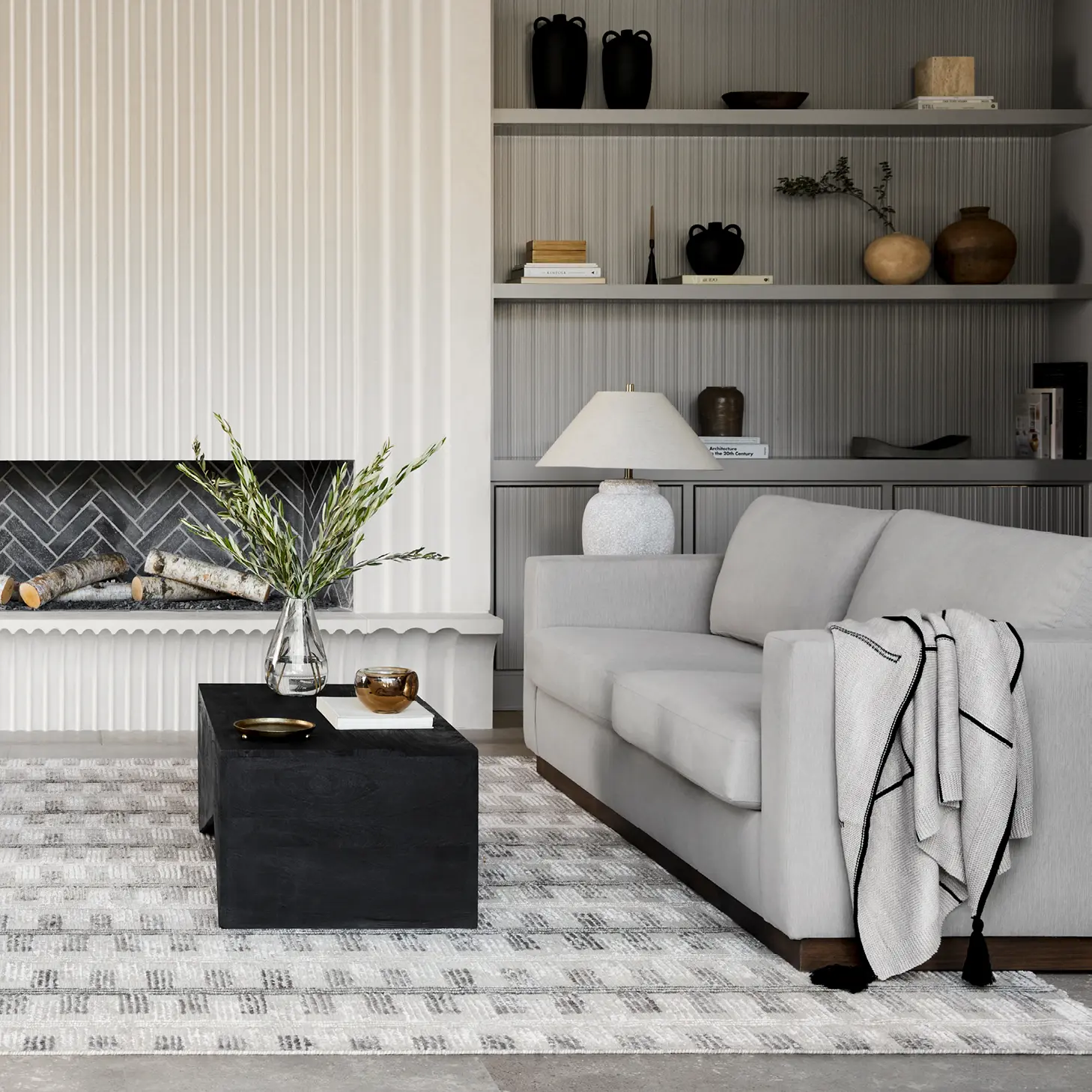

LIVING ROOM #1:
ALL LEGS ON THE RUG
9' x 12'

LIVING ROOM #2:
FRONT LEGS ON THE RUG
8' x 10'

LIVING ROOM #3:
ALL LEGS OFF THE RUG
5' x 8'
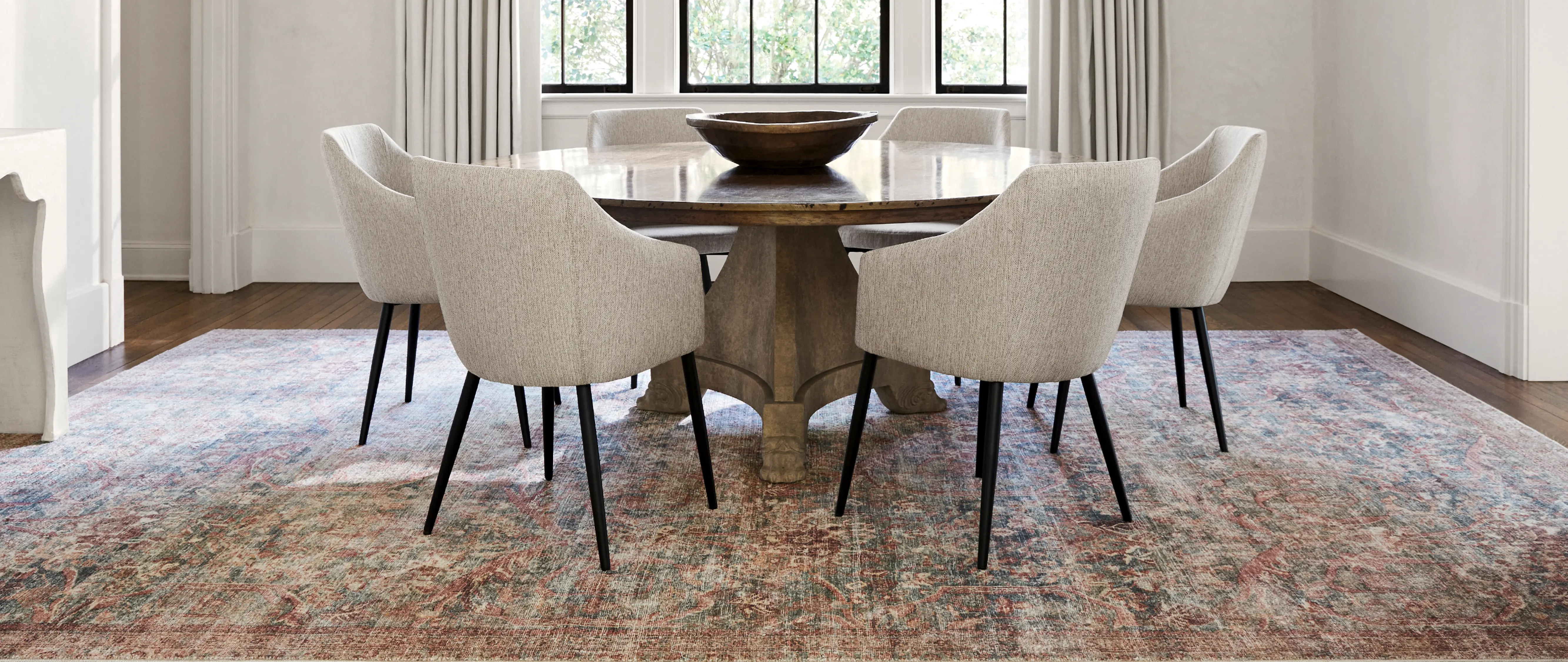
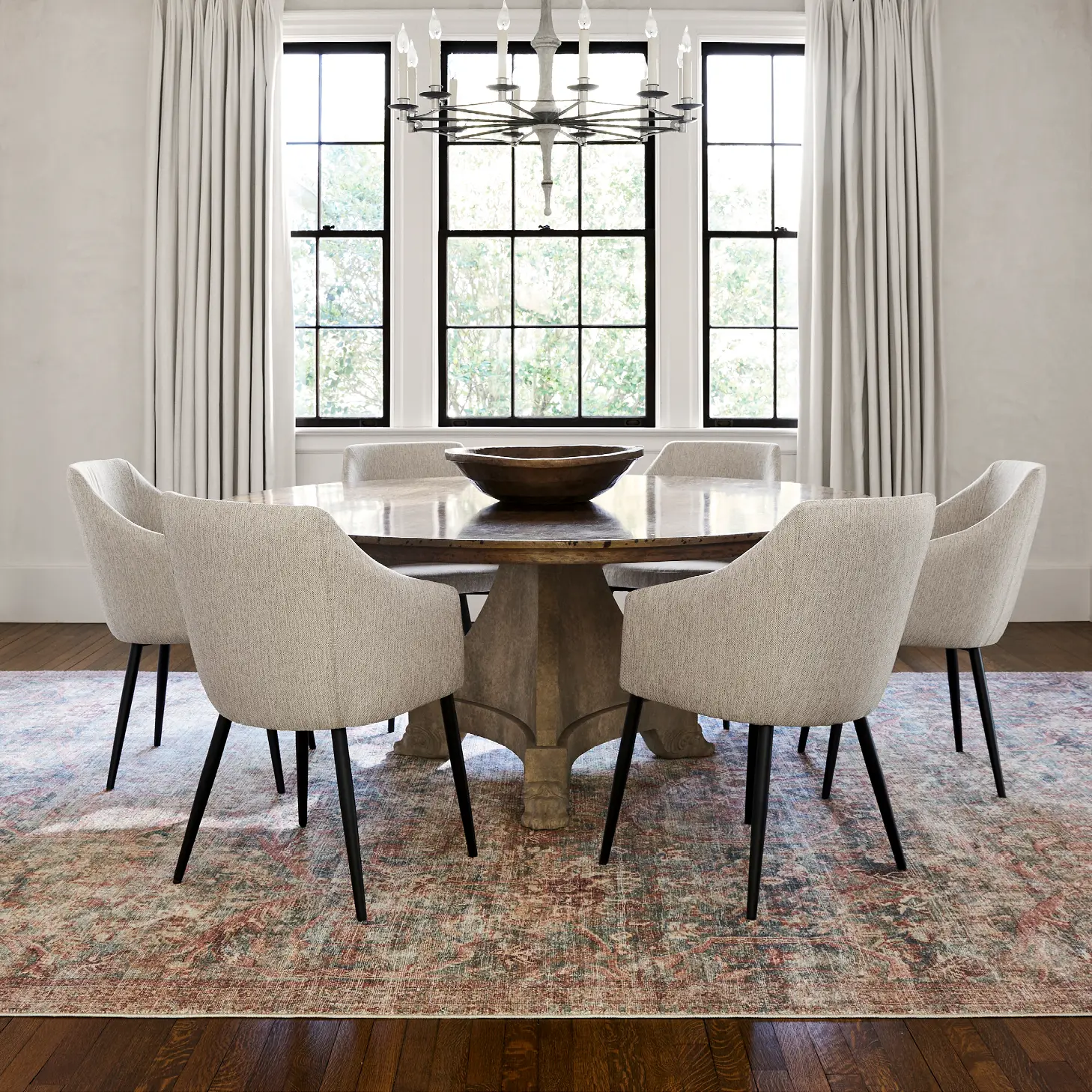

DINING ROOM #1:
DINING TABLE FOR 6
8' x 10'

DINING ROOM #2:
DINING TABLE FOR 8+
9' x 12'

DINING ROOM #3:
ROUND DINING TABLE
8' Round
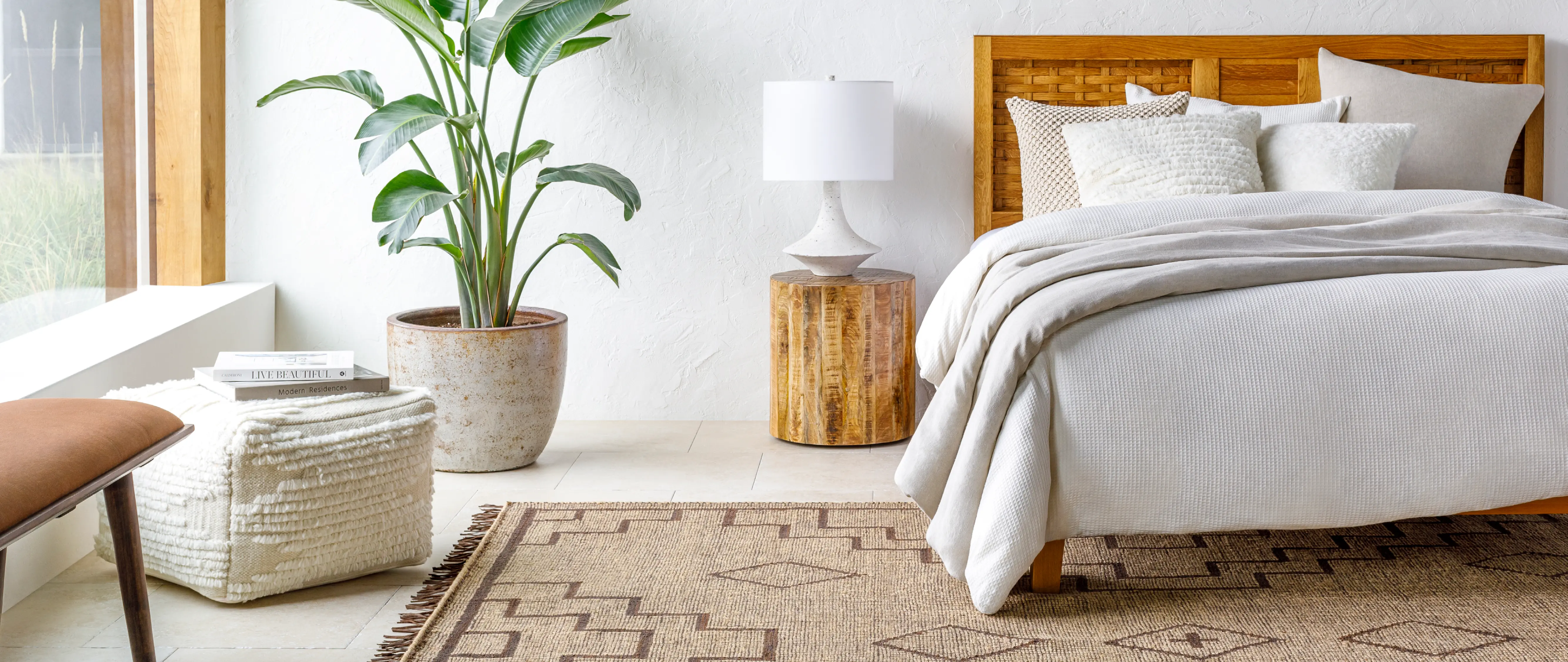
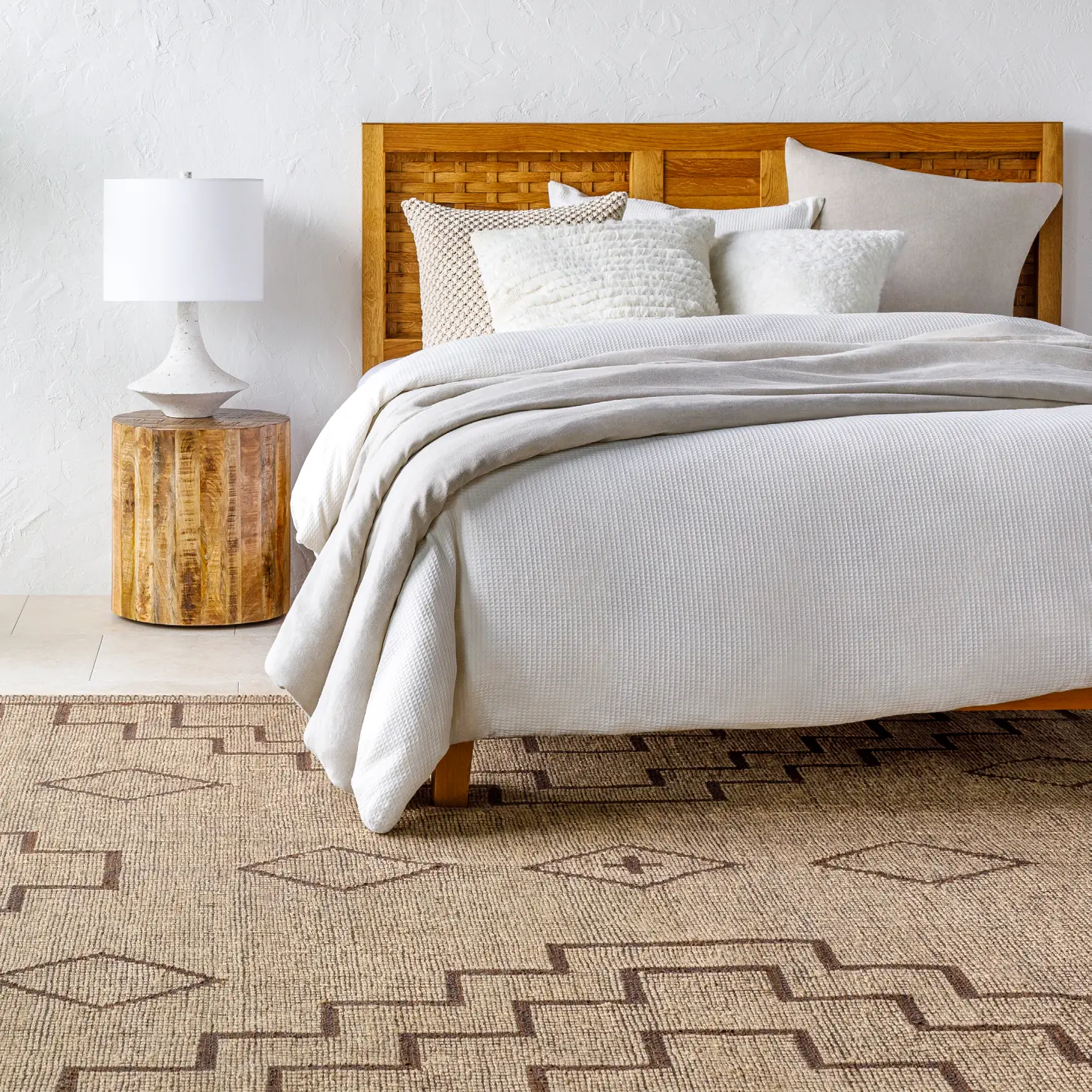

BEDROOM #1:
ALL FURNITURE ON THE RUG
8' x 10'

BEDROOM #2:
JUST THE BED ON THE RUG
6' x 9'

BEDROOM #3:
RUNNERS ON EACH SIDE
3' x 5'
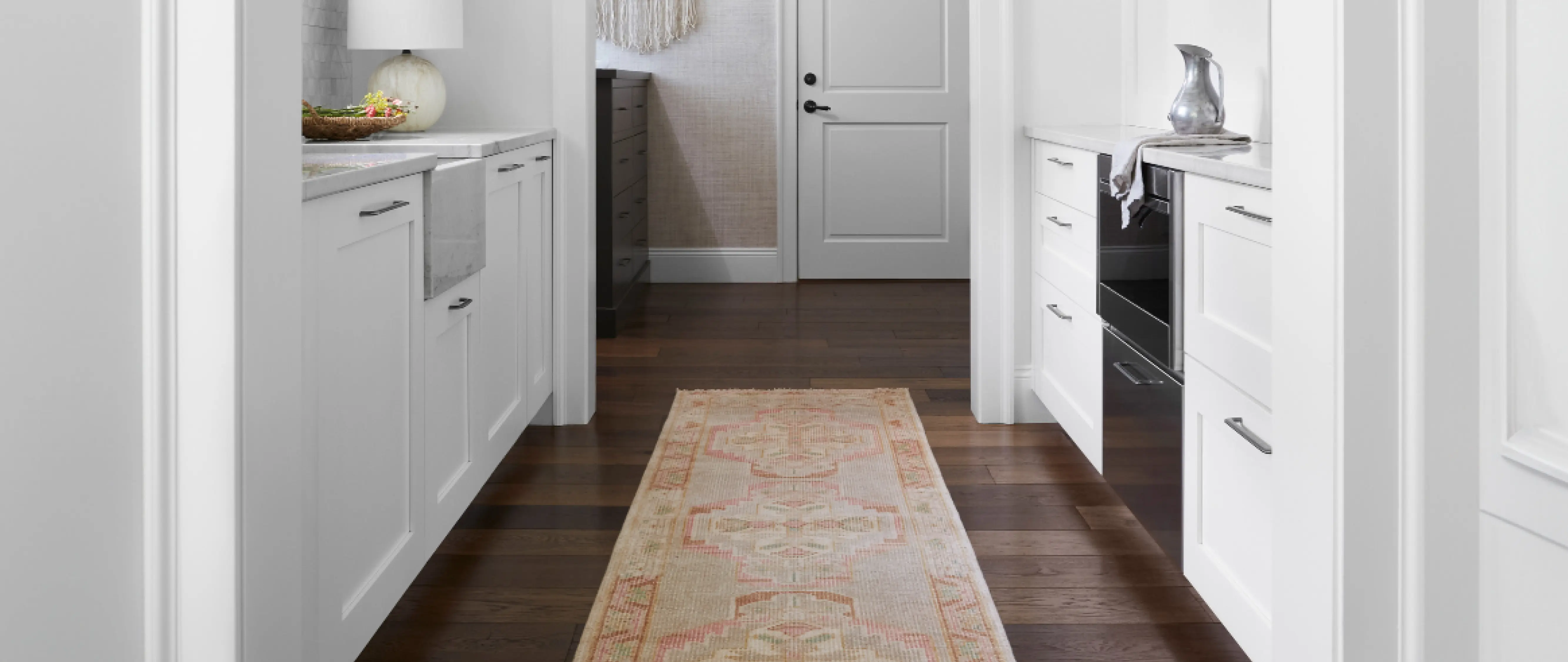
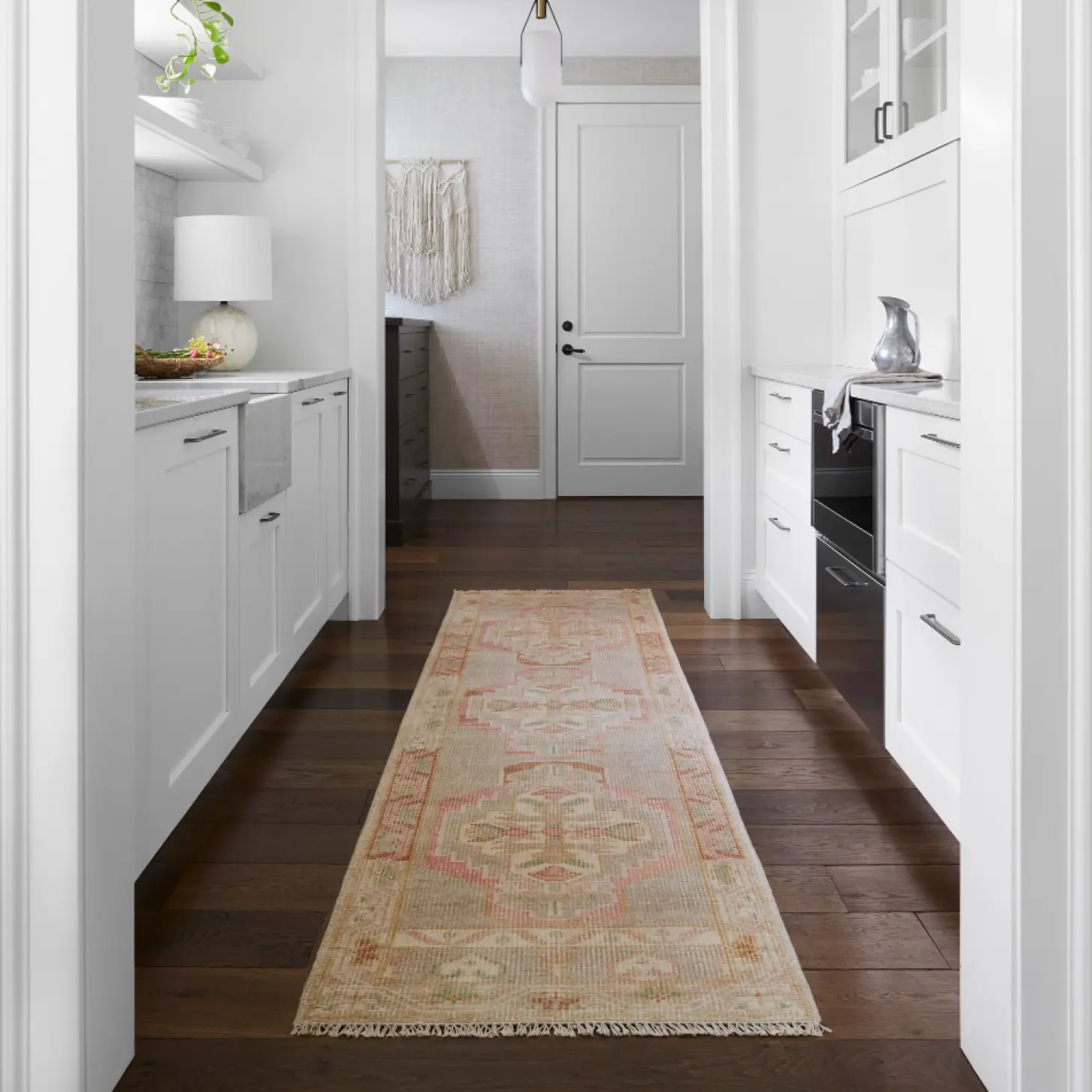

KITCHEN #1:
OPEN KITCHEN
5' x 8'

KITCHEN #2:
NARROW KITCHEN
2.5' x 8'
CARE & CLEANING
The following are general care and cleaning instructions that apply to any type of rug.
Canister vacuums without beater bars are the optimal type of vacuum to use on rugs.
Brooms and manual sweepers are also a gentle and effective way to clean rugs.
If you must use an upright vacuum, use the handheld attachment whenever possible.
If you are unable to use the handheld attachment on your upright vacuum, turn off the vacuum’s beater bar.
If the beater bar cannot be turned off, set it on the highest position possible before vacuuming.
Refrain from running the vacuum over the edges of the rug or the rugs. Instead, use the handheld attachment or carefully place the vacuum on the rug.
If a rug is reversible remember to vacuum both sides
Clean spills immediately. Once a stain is set it becomes much more difficult to clean.
Scrape off any food or debris with a dull instrument.
Blot the spill with a dry cotton cloth or a clean paper towel.
Work from the outer edges of the spill towards the center to prevent spreading.
Never rub a spill as this forces the spill deeper into the rug.
To remove any residual staining, dampen a cotton cloth or clean paper towel with clean, cold/lukewarm water. Gently blot with the damp cloth and quickly absorb the moisture on the rug.
Please note that Viscose and Tencel rugs should never be cleaned with any water or liquid.
Handmade rugs require a different cleaning process than wall-to-wall carpet, so be sure to choose a professional rug cleaning expert.
Inspect the rug with the cleaning expert prior to cleaning.
Get a signed receipt and guarantee of work before the work is performed.
Any damage resulting from the professional cleaning process is the responsibility of the cleaner.
The following are additional considerations based on specific rug construction types or materials.
Outdoor Safe products require regular care and cleaning, and should be stored in when they are not in use.
Leaving an outdoor rug in direct or indirect sunlight outdoors will cause rapid fading.
Store the rug in the shade when not in use. If you choose to leave your rug outdoors, shade it with an awning or umbrella.
Leaving an outdoor rug in rain or humid weather will cause rapid deterioration and/or mold. Store the rug in a dry space when not in use. If a rug is left in the rain by accident, hang the rug over a railing in sunlight until it has completely dried.
Outdoor Safe products that are damaged or aged prematurely due to negligence are not considered defective.
Hand Knotted Rugs - Use extra caution and care when cleaning because of the high value of these rugs.
Hand Woven (Flat Weave) - Regularly vacuum both sides of the rug to remove any grit that may cause premature wear.
Hand Woven (Shag/Texture) - Use extra caution and care when vacuuming; alternatively, you can take the rug outside to shake it out.
Wool/NZ Wool - Mix a small amount of dish soap with cold water to help remove stains; regular vacuuming will help to curtail shedding sooner.
Polypropylene/Olefin/Polyolefin - Mix a small amount of dish soap with cold water to help remove stains.
Polyester/Acrylic/Poly Acrylic/Nylon - Mix a small amount of dish soap with cold water to help remove stains.
Jute/Seagrass/Sisal - Regular vacuuming will help to curtail shedding sooner.
Viscose/Tencel - Never clean these rugs with water or any other liquid.
Pads
Rug pads provide a durable, long-lasting foundation. Not only do they bring comfort and cushion to your rugs, but they also protect floors underneath and reduce movement, bunching and slippage.


The Supreme Felted rug pad is made of 100% post-industrial recycled fibers. It features a textured rubber waffle backing for excellent grip on surfaces and provides the ultimate comfort, cushion and insulation.
Our highest quality rug pad with maximum cushion and insulation
Dual purpose: apply rubber side down on hard surfaces or apply felt side down for over-carpet application

The Premium Felted rug pad is made of 100% felt from recycled virgin waste materials. It features a textured rubber waffle backing for excellent grip on surfaces and provides premium cushion and insulation.
Premium quality rug pad
Excellent cushion, support and insulation
Dual purpose: apply rubber side down on hard surfaces or apply felt side down for over-carpet application

The Standard Felted rug pad is made of 100% felt from recycled virgin waste materials. It features a slip resistant rubber waffle backing and has good overall cushioning.
Lower profile for rugs that do not require the highest level of cushioning
Good cushion, support and insulation
Dual purpose: apply rubber side down on hard surfaces or apply felt side down for over-carpet application

The Luxury Grip rug pad is made of 100% PVC. It features a thick, luxurious open weave construction that allows for proper air flow on hard surfaces.
Soft and luxurious to the touch
Good cushion, support and structure

The Support Grip rug pad is made of 100% PVC. Featuring an open weave construction, it provides cushion and non-slip protection for hard surfaces.
Easy to trim
Soft cushion for hard surfaces
Open weave construction facilitates efficient air flow and vacuuming

The Secure Grip rug pad is made of 100% PVC. It features a tight ventilated grid system and provides reliable protection for hard surfaces.
Easy to trim
Provides non slip safe grip
Open weave construction facilitates efficient air flow and vacuuming

The Lock Grip rug pad is made of 100% PVC. It features an open ventilated grid system for maximum air flow while still providing protection for your rug at an exceptional value.
Easy to trim
Provides non slip safe grip
Open weave construction facilitates efficient air flow and vacuuming

The Outdoor rug pad is made of 100% Polymer Coated Polyester and is designed specifically for outdoor use. The open weave construction provides support and structure, and allows air to move under the rug to prevent mold growth.
Easy to trim
Mold and mildew resistant
Helps outdoor rugs dry faster
STORAGE
Your rug is much more vulnerable to damage when it is in storage than in day-to-day use. A rug in storage, especially if it has not been professionally cleaned and properly prepared for storage, can be damaged in a relatively short time. We recommend taking the following precautions when storing your rug.
Any rug that is unattended (such as under furniture, in a dark area or in storage) or has foodstuff or protein substances, such as accumulated pet hair, can attract moths. Moths prefer laying their larvae in tightly rolled rugs. Apply an insect and moth repellent that is specially designed for fabrics.
Unless a rug is very old and fragile, rolling it for storage is generally the most beneficial. To determine which way to roll your rug, decide which is more fragile: the back of the rug or the pile where the fibers are. In general, the pile is more delicate, meaning you should roll your rug with the pile facing inward. Make sure to roll it as straight as possible. If possible, roll the rug around a cardboard support tube. Folding, rather than rolling a rug, especially if it is stored for a long period of time, may cause creases that may be difficult to steam or clean out. Poorly folded rugs can also develop cracked foundations.
Wrap your carpet in a breathable fabric like a cotton sheet or muslin to keep it protected. If you want expert-level protection, consider wrapping your rug in a polyurethane rug wrap. These rug wraps are designed to provide a superior barrier against dampness and insects and will be more effective than muslin. Do not use plastic to wrap your rug, since it will keep it from breathing.
Synthetic (man-made) made by extruding polymers or petrochemicals and solution-dyed in a liquid state before it is formed into yarn. It is highly durable, moisture, fade and stain resistant, with minimal-to-no shedding or color variation. This material has a slight chemical odor which will fade over time.
To be safe, we suggest unrolling your rug once a month to make sure there is no evidence of insect infestation or mildew. Also, vacuum the area and the rug itself to eliminate any insect-attracting dust.
High performance, high design.
Soft, durable rugs made from 100% PET yarn, derived from recycled plastic bottles.
